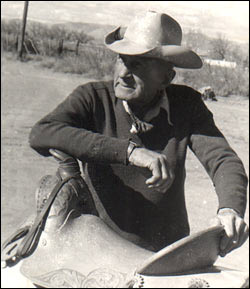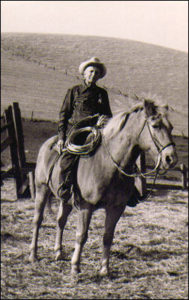Ed Connell’s Horsemanship

Ed Connell was a master horseman and teacher. Horsemen everywhere owe him a great debt of gratitude for writing down the process to training horses in Hackamore Reinsman, Reinsman of the West — Bridles and Bits, and Vaquero Style Horsemanship. (pictured here in McNeil, Arizona (1973) (photo from hackamore-reinsman.com used with permission)
Last week, I interviewed and wrote about Martha Crawford Cantarini. She mentioned how her horsemanship skills were influenced by Ed Connell. She said, “Ed Connell was without a doubt, one of, if not the finest horseman California ever produced.”
Ed Connell was born in 1900 in Livermore, California. He went on to become a great horseman and one of the first clinicians to bring the vaquero style of training horses to the horse-owning public. Most horse training clinicians today have been influenced by Ed’s training styles whether they know it or not.
In 1952, Ed Connell published Hackamore Reinsman, a book that “remains the Bible of all books on hackamore training.” When it came out, it was so popular that between 1952 and 1978, 14 re-editions were printed. Besides Hackamore Reinsman, Ed also wrote Reinsman of the West – Bridles and Bits, a companion book that outlines how to move the horse from the hackamore to the spade bit.
Ed Connell’s books have been used as textbooks in colleges all over the United States and Canada including by my father, Dr. Doug Butler. He taught colt training and horsemanship classes along with his horseshoeing classes for many years in colleges all over the country and Hackamore Reinsman and Reinsman of the West – Bridles and Bits were required reading!
My dad introduced me to these books when I began to get interested in training horses. I have read and re-read these books many times and I always get something new out of them. What makes the books so great is that they discuss not only the finer parts of horsemanship like riding and light hands on the reins, but also how to get a horse to stand for trimming and shoeing. This is valuable information to a farrier!
Ed Connell was more than happy to help trainers all across the world, so he wrote many letters to clarify training points. He also wrote many articles for magazines and other publications over the years. After his death in 1977, Ed’s daughter Leslee Connell Schwartz, took it upon herself to compile a third book, Vaquero Style Horsemanship. This book is full of articles and letters, to and from Ed Connell, that make the training process so much clearer. It is a valuable companion piece to the other two books. Leslee played a large role in making sure the books stayed in print for years. She began republishing Hackamore Reinsman in 1994.
Recently, I was honored to sit down with Leslee Connell Schwartz and interview her about her dad’s life and the contributions he made to horse handling and training. She told some amazing stories about her father, including some about the special bond that he had with horses.

Ed on Old Abe in Livermore, California 1969 (photo from hackamore-reinsman.com used with permission)
According to Leslee, during the Great Depression, Ed would ride bucking horses at the rodeo to make a little extra money. Ed had trained many horses at this point in his career, in California as well as Nevada. At a rodeo in Salinas, California, Ed drew a horse named Cougar, that the announcer described as a “mean and nasty horse that no one could ride.” Ed got on the horse and nodded for the gate to open, but nothing happened. The horse stood still and Ed said he had a strange feeling that the horse was familiar. It turned out, that the horse was one that Ed had trained two years earlier in Nevada. After training, the horse was turned over to a new trainer who did not understand the hackamore training method. He ruined the horse to the extent that he could no longer be handled so the man sold the horse to the rodeo circuit to be used as a bucking horse. When Ed realized that he knew the horse, he rode the horse out into the arena, and to the delight of the crowd, he demonstrated all that the horse had been trained to do in a hackamore. He ran him down the fence line, doubling him first and then went to the center of the arena, spun him around, backed him up and galloped him down further and then sat him down, sliding him. The crowd gave a standing ovation. Ed said that if a horse has been trained properly, he will never forget.
This special connection that Ed shared with horses was, perhaps, most significantly illustrated on the day that he died. Ed was giving a clinic in Canada when he had a heart attack. Those in attendance said that “when [Ed] passed away, the horses [he’d been working with] walked away and no one could do anything with them.” At the same time, miles away, in California where Ed had been staying at the time, the horses there began to act up and kept circling Ed’s car and they would “bite and scrape the hood and trunk especially.” Jack Chandler, unaware yet that Ed had died, tried to calm the horses down but to no avail. Somehow, the horses knew they had lost a true advocate.
Leslee shared these stories and more to paint a picture of the kind of man Ed Connell was. Today, fewer people know who the legendary horse trainer was, but some people, like Leslee, endeavor to keep the legacy of this great man alive.
Horse trainer and clinician, Martin Black is one of these people. Martin has helped many horses and horse trainers over the years. He credits Ed, as well as many others, as “being a big part of the foundation of my education.” A few years ago, he bought the printing rights in order to keep Ed’s books in production. He said he couldn’t let the books go out of print because “it’d be like the Bible going out of production.” You can buy Ed Connell’s books, as well as Martin’s other educational materials, here.
To listen to the complete interview with Leslee and to hear the stories about her father, Ed Connell, you can listen here or download the Farrier Focus Podcast on Stitcher or iTunes.
You can also look at Leslee’s excellent website about Ed Connell at hackamore-reinsman.com.
Related Posts
-
The horse’s foot is a bio-mechanical marvel with many part...Feb 21, 2019 / 0 comments
-
When a horse requires protection from excessive foot abrasio...Feb 14, 2019 / 0 comments
-
Competent farriers are sometimes unfairly accused of inflict...Feb 28, 2019 / 0 comments
Blog Categories
- Anatomy
- Best Business Practices
- Conformation
- Current Events
- Customer Service
- Draft Horse Shoeing
- Equine Soundness
- Essential Anatomy Kit
- Farrier Careers
- Farrier training
- Foal soundness
- Horse Care
- Horse Foot Care
- Horse Owner Tips
- Horsemanship
- Horseshoeing
- Horseshoeing History
- Iron and Forge Work
- Student Spotlight
- Uncategorized
- Veterinary Care
Blog Archives
Contact Us
Butler Professional Horseshoeing School
495 Table Road
Crawford, NE 69339
(800) 728-3826
jacob@dougbutler.com
Subscribe to Our Blog
Get Our Free e-Book!
If you think you want to become a farrier (or know someone who does), this book can help you make that decision. Horse owners will learn the importance of choosing a qualified farrier and how to select the “right” one.
[ Get the e-Book Now! ]
- Follow:
